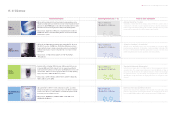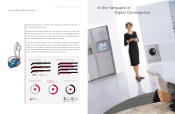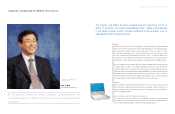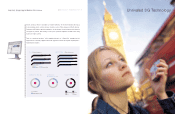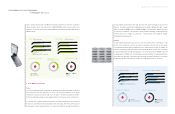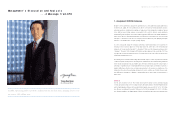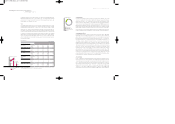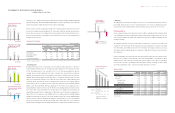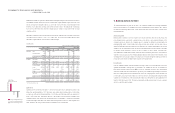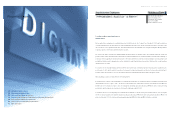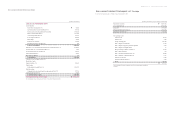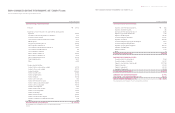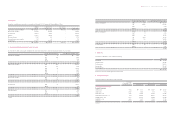LG 2002 Annual Report Download - page 23
Download and view the complete annual report
Please find page 23 of the 2002 LG annual report below. You can navigate through the pages in the report by either clicking on the pages listed below, or by using the keyword search tool below to find specific information within the annual report.
(Billions of Korean Won)
Profit
3,686
796
574
507
Gross Profit
Operating Profit
Recurring Profit
Net Profit
3,174
662
399
278
4,349
1,029
675
498
01 02 02
April-December
Profit
Gross Profit 3,686 4,349 3,174 18.0
Profit Margin 22.2% 23.4% 22.8%
Operating Profit 796 1,029 662 29.2
Profit Margin 4.8% 5.5% 4.8%
Recurring Profit 574 675 399 17.7
Profit Margin 3.5% 3.6% 2.9%
Net Profit 507 498 278 -1.9
Profit Margin 3.1% 2.7% 2.0%
2001 2002 Change(%)
(Billions of Korean Won)
LG Electronics Inc. IAnnual Report 2002 I42 43
January-December Pro forma April-December
* Change % is year-on-year basis.
(%)
(%)
Domestic Sales Breakdown
of Mobile Handset
LG Telecom
KTF
SK Telecom
Direct Distribution
GSM CDMA
12
36
26
Exports Breakdown of Mobile Handset
26 22
56
21
71
15 77
14 9
78
China
Europe
Russia
Others
North America
Latin America
China
Others
(%)
the Company climbed four places to rank 6th in the global mobile handset market in 2002. Of total
shipments, CDMA handsets accounted for 83.5% with approximately 13.3 million units while GSM handsets
represented the remaining 16.5%. In the domestic market, sales of units to local service providers SK
Telecom, LG Telecom and KTF accounted for 36% , 26% and 26% respectively. The remaining 12% were sold
through direct distribution channels. In terms of export volume in 2002, CDMA handsets were again
dominant with a 78% share, while GSM handsets accounted for 22%. Of CDMA handset sales to foreign
countries, North America, mainly through Verizon and Sprint, accounted for 71% , followed by Latin America
with 15% and China with 7%. In the case of GSM handset sales to foreign nations, China represented 56%,
well ahead of Europe at 21% and Russia at 14%. With GSM handsets in particular, the Company successfully
penetrated Southern European markets with sales through operators such as Orange, Wind, and Telefonica.
In China, the Company sold over 1.5 million GSM handsets through companies including Legend, Eastcom
and Bodao, and over 0.6 million LG-branded CDMA handsets through China Unicom in the second half of the
year.
> Telecommunication System
In contrast to the Company’s three other divisions, which recorded double-digits sales growth, the
Telecommunication System Division performed poorly in 2002. Sales declined 39.5% to 903.8 billion won. As
a result, the proportion of the Division’s sales to the Company’s total sales fell to 4.9% in 2002 from 9.4% in
2001. The main factor behind the disappointing result was a sharp decline in domestic sales, which inevitably
suffered from a decrease in overall capital expenditure by telecommunications operators. In addition, strategic
withdrawal from non-profitable businesses such as network solutions and data networks, led to a decline in
the Division's sales. In 2002, the Division focused on improvement of profitability and building the basis of
3G. In addition, the Division achieved some notable successes, including the right to provide WCDMA
equipment to KTiCOM, and was chosen as one of the co-developers for Softswitch with Korea Telecom.
Backed by the Division’s vigorous restructuring, profitability improved toward the end of the fiscal year.
Income
Operating profit increased 29.2% to 1.03 trillion won on the back of robust sales growth and increasing
weight of high-end products. Recurring profit rose 17.1% to 675.2 billion won while net profit dipped 1.9%
to 497.6 billion won.
> Gross profit
Gross profit rose 18.0% to 4.35 trillion won in 2002 from 3.69 trillion won in 2001 on the back of robust
sales increases. Gross profit margin improved 1.2%p from 22.2% in 2001 to 23.4% in 2002. Overall, the
high portion of high-end products such as digital TVs and handsets brought about the improvement. By
division, the Mobile Handset Division became the most profitable division with a 30.1% gross profit margin in
2002 compared to 26.9% in 2001. The Digital Appliance Division lost its top position since its gross margin,
albeit still high, fell slightly to 28.9% in 2002 from 31.0% in 2001. Boosted by the strong demand for high-
priced products such as digital TVs, A/V equipment and CD-RWs, the Digital Display and Media Division
enjoyed the biggest gain in gross profit margin improving to 16.2% in 2002 from 12.6% in 2001. On the
other hand, the Telecommunication System Division, which experienced a sharp decline in sales, failed to
show improvement in profitability. Gross profit margin of the Division fell to 23.3% in 2002 from 26.4% in 2001.
> Operating profit
The effect of improving gross profit margin trickled down to operating profitability since there was no
significant impact on operating profit margin from SG&A expenses. Operating profit margin improved to 5.5%
in 2002 compared to the previous year’s 4.8%. Thus the Company's operating profit increased 29.2% to 1.03
trillion won, passing one trillion won for the first time in 2002, from 796.0 billion won in 2001. By division, the
Digital Appliance Division remained the most profitable with operating profit margin of 10.0% . Although this
was a slight drop from the previous year’s 12.1%, due mainly to the strong Korean won and a rise in
marketing expenses, increasing demand for high-end products such as Kimchi refrigerators and drum washing
machines maintained the overall high margin. The most significant improvement in terms of profitability,
however, was achieved by the Handset Division. Operating profit margin from this Division improved by 3.2%p
to 9.7% in 2002 posting 342.7 billion won of operating profit in 2002, 117.9% higher from a year earlier.
Given that the Division contributed 18.9% to the Company’s revenue, but accounted for 30.3% to total
operating profit in 2002, it was the driving force for the structural change. On the other hand, the Digital
Display and Media Division, which generated 42.7% of the Company’s operating revenue, continued to exhibit
low profitability. However, the operating profit margin of the Division improved to 3.2%, higher than the
LG전자 - 본문 2003.4 .22 7:15 AM 페이지46


